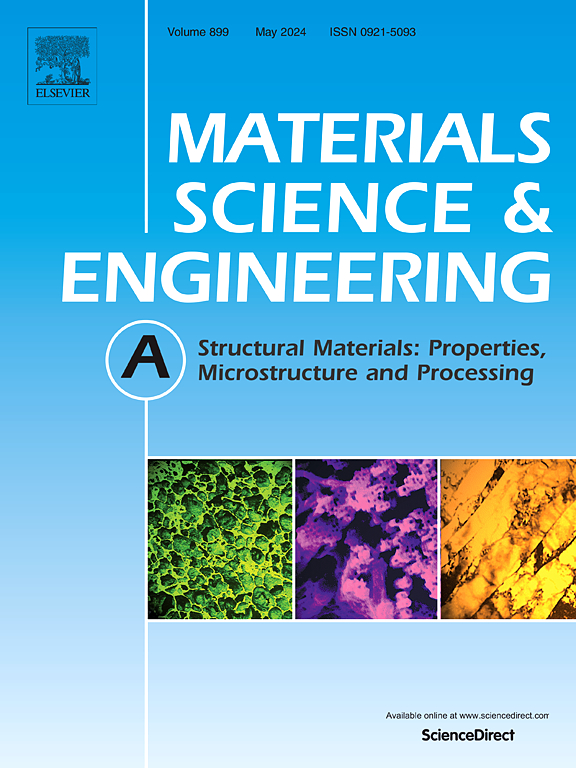Effect of La content on inclusions, grain refinement, and impact toughness in low alloy wear-resistant steel: in-situ tensile testing and EBSD orientation analysis of inclusions
IF 7
2区 材料科学
Q1 MATERIALS SCIENCE, MULTIDISCIPLINARY
引用次数: 0
Abstract
In the current study, the effects of varying La concentrations—specifically 0, 25, 40, and 96 ppm—on the feature of inclusions, the alteration of prior austenite grain size, and the impact toughness of the low alloy wear-resistant steel were systematically investigated. As the La content in the steel increased, the impact toughness first rose and then decreased, reaching a maximum of 76.83 J cm−2 at 40 ppm La, with an increase of 19.6 %. The improvement in impact toughness primarily depended on the beneficial effects of La on inclusions and grain refinement. Adding La reduced the quantity of large non-metallic inclusions and the proportion of multiphase inclusions, which significantly improved the impact toughness. However, at 96 ppm La, the occurrence of large-sized La-O-P-As compromised impact toughness. With the increase in La content from 0 ppm to 96 ppm, the prior austenite grain size decreased, achieving the optimal refinement effect (from 14.18 μm to 9.94 μm) at 96 ppm. This is because the number of fine-dispersed inclusions (LaAlO3 and La2O2S) that could act as nucleation sites increased significantly. EBSD showed that fine prior austenite grains were only present around the La2O2S (100), regardless of single-phase or multiphase inclusions. This indicated that if inclusions had planes with suitable planar disregistry matching the γ-Fe, they could serve as cores for heterogeneous nucleation. However, the ability of single-phase inclusions for heterogeneous nucleation was much higher than that of multiphase inclusions. The optimal performance was observed at 40 ppm La due to the ideal balance of inclusion type, size, and prior austenite grain refinement.
La含量对低合金耐磨钢中夹杂物、晶粒细化和冲击韧性的影响:原位拉伸试验和夹杂物的EBSD取向分析
在本研究中,系统地研究了不同浓度的La(0、25、40和96 ppm)对低合金耐磨钢夹杂物特征、奥氏体晶粒尺寸的改变和冲击韧性的影响。随着钢中La含量的增加,钢的冲击韧性先升高后降低,在La含量为40 ppm时达到最大值76.83 J cm−2,增加了19.6%。冲击韧性的提高主要取决于La对夹杂物和晶粒细化的有利作用。添加La减少了大型非金属夹杂物的数量和多相夹杂物的比例,显著提高了冲击韧性。然而,在96 ppm La时,大尺寸La- o - p - as的出现降低了冲击韧性。随着La含量从0 ppm增加到96 ppm,奥氏体晶粒尺寸减小,在96 ppm时达到最佳细化效果(从14.18 μm到9.94 μm)。这是因为可以作为成核位点的细分散包裹体(LaAlO3和La2O2S)数量显著增加。EBSD显示,La2O2S(100)周围只存在细小的奥氏体晶粒,而不存在单相或多相夹杂物。这表明,如果包裹体具有与γ-Fe相匹配的平面失配面,则可以作为非均相成核的核芯。而单相夹杂物的非均相成核能力远高于多相夹杂物。由于包裹体类型、尺寸和先前的奥氏体晶粒细化达到了理想的平衡,在40 ppm的La下观察到最佳性能。
本文章由计算机程序翻译,如有差异,请以英文原文为准。
求助全文
约1分钟内获得全文
求助全文
来源期刊

Materials Science and Engineering: A
工程技术-材料科学:综合
CiteScore
11.50
自引率
15.60%
发文量
1811
审稿时长
31 days
期刊介绍:
Materials Science and Engineering A provides an international medium for the publication of theoretical and experimental studies related to the load-bearing capacity of materials as influenced by their basic properties, processing history, microstructure and operating environment. Appropriate submissions to Materials Science and Engineering A should include scientific and/or engineering factors which affect the microstructure - strength relationships of materials and report the changes to mechanical behavior.
 求助内容:
求助内容: 应助结果提醒方式:
应助结果提醒方式:


